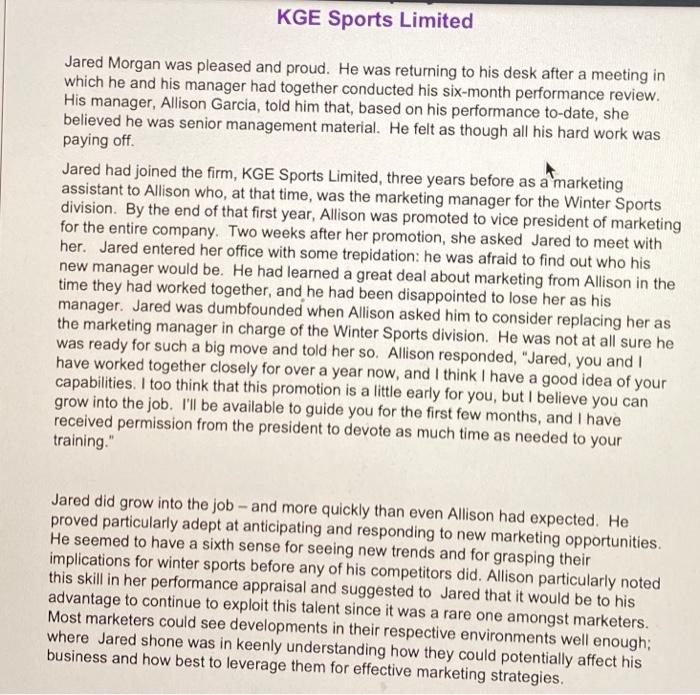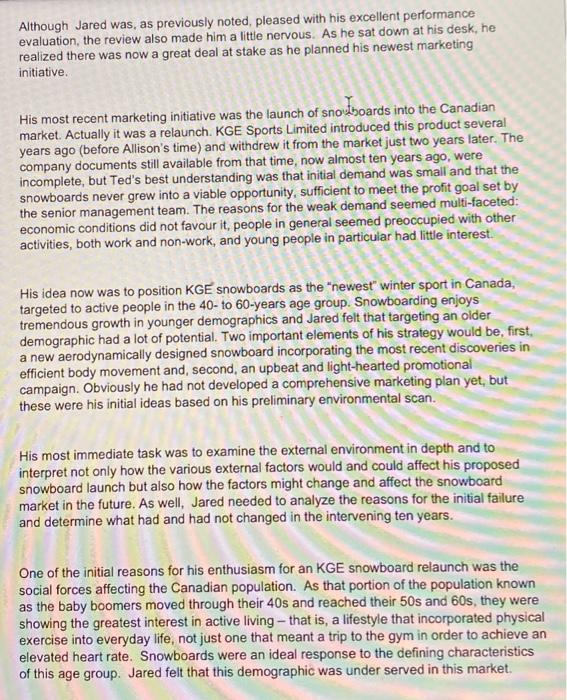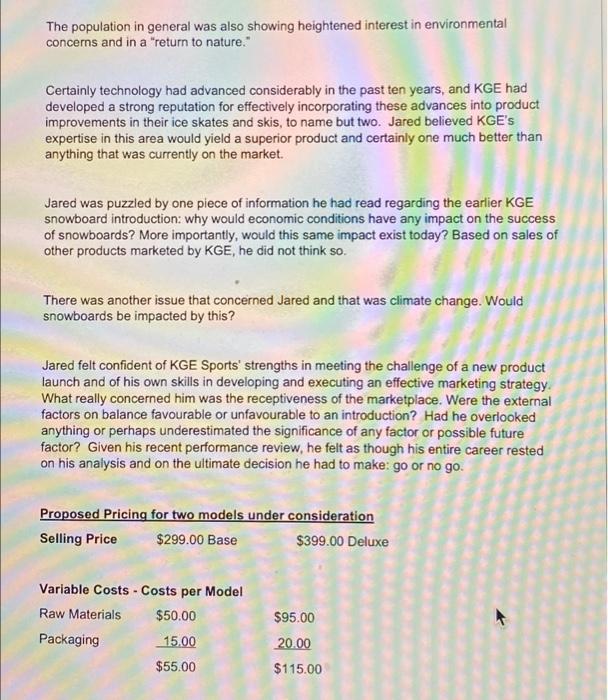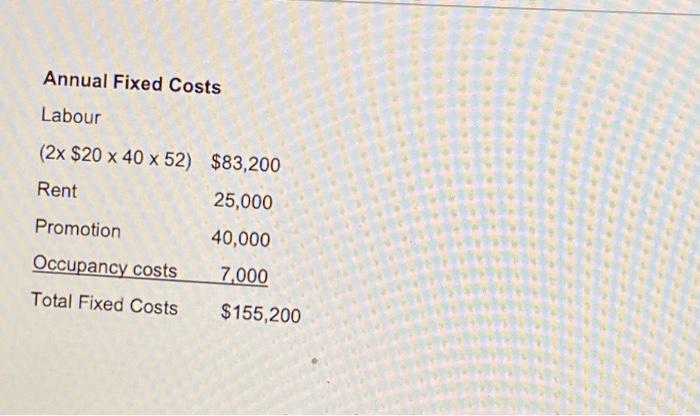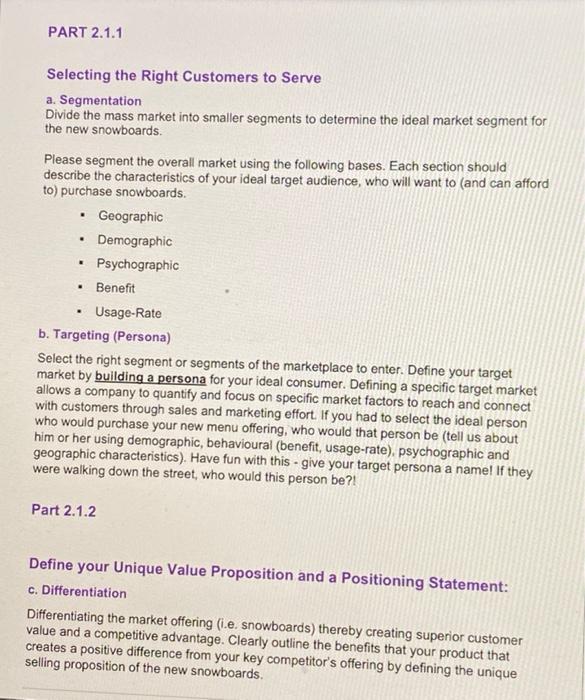KGE Sports Limited Jared Morgan was pleased and proud. He was returning to his desk after a meeting in which he and his manager had together conducted his six-month performance review. His manager, Allison Garcia, told him that, based on his performance to-date, she believed he was senior management material. He felt as though all his hard work was paying off. Jared had joined the firm, KGE Sports Limited, three years before as a marketing assistant to Allison who, at that time, was the marketing manager for the Winter Sports division. By the end of that first year, Allison was promoted to vice president of marketing for the entire company. Two weeks after her promotion, she asked Jared to meet with her. Jared entered her office with some trepidation: he was afraid to find out who his new manager would be. He had learned a great deal about marketing from Allison in the time they had worked together, and he had been disappointed to lose her as his manager. Jared was dumbfounded when Allison asked him to consider replacing her as the marketing manager in charge of the Winter Sports division. He was not at all sure he was ready for such a big move and told her so. Allison responded, "Jared, you and I have worked together closely for over a year now, and I think I have a good idea of your capabilities. I too think that this promotion is a little early for you, but I believe you can grow into the job. I'll be available to guide you for the first few months, and I have received permission from the president to devote as much time as needed to your training." Jared did grow into the job - and more quickly than even Allison had expected. He proved particularly adept at anticipating and responding to new marketing opportunities. He seemed to have a sixth sense for seeing new trends and for grasping their implications for winter sports before any of his competitors did. Allison particularly noted this skill in her performance appraisal and suggested to Jared that it would be to his advantage to continue to exploit this talent since it was a rare one amongst marketers. Most marketers could see developments in their respective environments well enough where Jared shone was in keenly understanding how they could potentially affect his business and how best to leverage them for effective marketing strategies. Although Jared was, as previously noted, pleased with his excellent performance evaluation, the review also made him a little nervous. As he sat down at his desk, he realized there was now a great deal at stake as he planned his newest marketing initiative. His most recent marketing initiative was the launch of snowboards into the Canadian market. Actually it was a relaunch. KGE Sports Limited introduced this product several years ago (before Allison's time) and withdrew it from the market just two years later. The company documents still available from that time, now almost ten years ago, were incomplete, but Ted's best understanding was that initial demand was small and that the snowboards never grew into a viable opportunity, sufficient to meet the profit goal set by the senior management team. The reasons for the weak demand seemed multi-faceted: economic conditions did not favourit, people in general seemed preoccupied with other activities, both work and non-work, and young people in particular had little interest. His idea now was to position KGE snowboards as the newest winter sport in Canada, targeted to active people in the 40-to 60-years age group. Snowboarding enjoys tremendous growth in younger demographics and Jared felt that targeting an older demographic had a lot of potential. Two important elements of his strategy would be, first, a new aerodynamically designed snowboard incorporating the most recent discoveries in efficient body movement and, second, an upbeat and light-hearted promotional campaign. Obviously he had not developed a comprehensive marketing plan yet, but these were his initial ideas based on his preliminary environmental scan. His most immediate task was to examine the external environment in depth and to interpret not only how the various external factors would and could affect his proposed snowboard launch but also how the factors might change and affect the snowboard market in the future. As well, Jared needed to analyze the reasons for the initial failure and determine what had and had not changed in the intervening ten years. One of the initial reasons for his enthusiasm for an KGE snowboard relaunch was the social forces affecting the Canadian population. As that portion of the population known as the baby boomers moved through their 40s and reached their 50s and 60s, they were showing the greatest interest in active living - that is, a lifestyle that incorporated physical exercise into everyday life, not just one that meant a trip to the gym in order to achieve an elevated heart rate. Snowboards were an ideal response to the defining characteristics of this age group. Jared felt that this demographic was under served in this market. The population in general was also showing heightened interest in environmental concerns and in a "return to nature." Certainly technology had advanced considerably in the past ten years, and KGE had developed a strong reputation for effectively incorporating these advances into product improvements in their ice skates and skis, to name but two. Jared believed KGE's expertise in this area would yield a superior product and certainly one much better than anything that was currently on the market. Jared was puzzled by one piece of information he had read regarding the earlier KGE snowboard introduction: why would economic conditions have any impact on the success of snowboards? More importantly, would this same impact exist today? Based on sales of other products marketed by KGE, he did not think so. There was another issue that concerned Jared and that was climate change. Would Snowboards be impacted by this? Jared felt confident of KGE Sports' strengths in meeting the challenge of a new product launch and of his own skills in developing and executing an effective marketing strategy What really concerned him was the receptiveness of the marketplace. Were the external factors on balance favourable or unfavourable to an introduction? Had he overlooked anything or perhaps underestimated the significance of any factor or possible future factor? Given his recent performance review, he felt as though his entire career rested on his analysis and on the ultimate decision he had to make: go or no go. Proposed Pricing for two models under consideration Selling Price $299.00 Base $399.00 Deluxe $95.00 Variable Costs - Costs per Model Raw Materials $50.00 Packaging 15.00 $55.00 20.00 $115.00 Annual Fixed Costs Labour (2x $20 x 40 x 52) $83,200 Rent 25,000 Promotion 40,000 Occupancy costs 7,000 Total Fixed Costs $155,200 PART 2.1.1 . . Selecting the Right Customers to Serve a. Segmentation Divide the mass market into smaller segments to determine the ideal market segment for the new snowboards Please segment the overall market using the following bases. Each section should describe the characteristics of your ideal target audience, who will want to (and can afford to) purchase snowboards. Geographic Demographic Psychographic Benefit Usage-Rate b. Targeting (Persona) Select the right segment or segments of the marketplace to enter. Define your target market by building a persona for your ideal consumer. Defining a specific target market allows a company to quantify and focus on specific market factors to reach and connect with customers through sales and marketing effort. If you had to select the ideal person who would purchase your new menu offering, who would that person be (tell us about him or her using demographic, behavioural (benefit, usage-rate), psychographic and geographic characteristics). Have fun with this - give your target persona a name! If they were walking down the street, who would this person be?! . Part 2.1.2 Define your unique Value Proposition and a Positioning Statement: c. Differentiation Differentiating the market offering (i.e. snowboards) thereby creating superior customer value and a competitive advantage. Clearly outline the benefits that your product that creates a positive difference from your key competitor's offering by defining the unique selling proposition of the new snowboards. d. Positioning Statement & Perceptual Map Placing the product offering in the minds of the target consumer with the right messaging requires a strong positioning statement. Create a positioning statement for KGE's snowboards. Marketers often prepare perceptual (positioning) maps, which show consumer perceptions of their products vs. competing products on important buying dimensions (see sample on following page): Using a perceptual map using the following 2 Axis: 1. Low Price - High Price; and 2. Low Quality - High Quality menu offerings. Compare KGE's snowboards to its 5-10 closest competitors using price and quality. Note: competitors should offer similar items that can compare somewhat in price and quality in this market. Place KGE on the map and indicate where it compares against its closest competitors in when considering price and quality to service the target audience. Provide a brief explanation of your group's findings and interpretation of the results. Include the name and/or logo of the items included in your perceptual map and ensure that it is clearly legible (or that a legend is included). Ensure that your research accurately supports your competitive product mapping. . A sample of a perceptual map Price 3D Aude Low Quality CITROEN el High Quality TOYOTA CE Low Price KGE Sports Limited Jared Morgan was pleased and proud. He was returning to his desk after a meeting in which he and his manager had together conducted his six-month performance review. His manager, Allison Garcia, told him that, based on his performance to-date, she believed he was senior management material. He felt as though all his hard work was paying off. Jared had joined the firm, KGE Sports Limited, three years before as a marketing assistant to Allison who, at that time, was the marketing manager for the Winter Sports division. By the end of that first year, Allison was promoted to vice president of marketing for the entire company. Two weeks after her promotion, she asked Jared to meet with her. Jared entered her office with some trepidation: he was afraid to find out who his new manager would be. He had learned a great deal about marketing from Allison in the time they had worked together, and he had been disappointed to lose her as his manager. Jared was dumbfounded when Allison asked him to consider replacing her as the marketing manager in charge of the Winter Sports division. He was not at all sure he was ready for such a big move and told her so. Allison responded, "Jared, you and I have worked together closely for over a year now, and I think I have a good idea of your capabilities. I too think that this promotion is a little early for you, but I believe you can grow into the job. I'll be available to guide you for the first few months, and I have received permission from the president to devote as much time as needed to your training." Jared did grow into the job - and more quickly than even Allison had expected. He proved particularly adept at anticipating and responding to new marketing opportunities. He seemed to have a sixth sense for seeing new trends and for grasping their implications for winter sports before any of his competitors did. Allison particularly noted this skill in her performance appraisal and suggested to Jared that it would be to his advantage to continue to exploit this talent since it was a rare one amongst marketers. Most marketers could see developments in their respective environments well enough where Jared shone was in keenly understanding how they could potentially affect his business and how best to leverage them for effective marketing strategies. Although Jared was, as previously noted, pleased with his excellent performance evaluation, the review also made him a little nervous. As he sat down at his desk, he realized there was now a great deal at stake as he planned his newest marketing initiative. His most recent marketing initiative was the launch of snowboards into the Canadian market. Actually it was a relaunch. KGE Sports Limited introduced this product several years ago (before Allison's time) and withdrew it from the market just two years later. The company documents still available from that time, now almost ten years ago, were incomplete, but Ted's best understanding was that initial demand was small and that the snowboards never grew into a viable opportunity, sufficient to meet the profit goal set by the senior management team. The reasons for the weak demand seemed multi-faceted: economic conditions did not favourit, people in general seemed preoccupied with other activities, both work and non-work, and young people in particular had little interest. His idea now was to position KGE snowboards as the newest winter sport in Canada, targeted to active people in the 40-to 60-years age group. Snowboarding enjoys tremendous growth in younger demographics and Jared felt that targeting an older demographic had a lot of potential. Two important elements of his strategy would be, first, a new aerodynamically designed snowboard incorporating the most recent discoveries in efficient body movement and, second, an upbeat and light-hearted promotional campaign. Obviously he had not developed a comprehensive marketing plan yet, but these were his initial ideas based on his preliminary environmental scan. His most immediate task was to examine the external environment in depth and to interpret not only how the various external factors would and could affect his proposed snowboard launch but also how the factors might change and affect the snowboard market in the future. As well, Jared needed to analyze the reasons for the initial failure and determine what had and had not changed in the intervening ten years. One of the initial reasons for his enthusiasm for an KGE snowboard relaunch was the social forces affecting the Canadian population. As that portion of the population known as the baby boomers moved through their 40s and reached their 50s and 60s, they were showing the greatest interest in active living - that is, a lifestyle that incorporated physical exercise into everyday life, not just one that meant a trip to the gym in order to achieve an elevated heart rate. Snowboards were an ideal response to the defining characteristics of this age group. Jared felt that this demographic was under served in this market. The population in general was also showing heightened interest in environmental concerns and in a "return to nature." Certainly technology had advanced considerably in the past ten years, and KGE had developed a strong reputation for effectively incorporating these advances into product improvements in their ice skates and skis, to name but two. Jared believed KGE's expertise in this area would yield a superior product and certainly one much better than anything that was currently on the market. Jared was puzzled by one piece of information he had read regarding the earlier KGE snowboard introduction: why would economic conditions have any impact on the success of snowboards? More importantly, would this same impact exist today? Based on sales of other products marketed by KGE, he did not think so. There was another issue that concerned Jared and that was climate change. Would Snowboards be impacted by this? Jared felt confident of KGE Sports' strengths in meeting the challenge of a new product launch and of his own skills in developing and executing an effective marketing strategy What really concerned him was the receptiveness of the marketplace. Were the external factors on balance favourable or unfavourable to an introduction? Had he overlooked anything or perhaps underestimated the significance of any factor or possible future factor? Given his recent performance review, he felt as though his entire career rested on his analysis and on the ultimate decision he had to make: go or no go. Proposed Pricing for two models under consideration Selling Price $299.00 Base $399.00 Deluxe $95.00 Variable Costs - Costs per Model Raw Materials $50.00 Packaging 15.00 $55.00 20.00 $115.00 Annual Fixed Costs Labour (2x $20 x 40 x 52) $83,200 Rent 25,000 Promotion 40,000 Occupancy costs 7,000 Total Fixed Costs $155,200 PART 2.1.1 . . Selecting the Right Customers to Serve a. Segmentation Divide the mass market into smaller segments to determine the ideal market segment for the new snowboards Please segment the overall market using the following bases. Each section should describe the characteristics of your ideal target audience, who will want to (and can afford to) purchase snowboards. Geographic Demographic Psychographic Benefit Usage-Rate b. Targeting (Persona) Select the right segment or segments of the marketplace to enter. Define your target market by building a persona for your ideal consumer. Defining a specific target market allows a company to quantify and focus on specific market factors to reach and connect with customers through sales and marketing effort. If you had to select the ideal person who would purchase your new menu offering, who would that person be (tell us about him or her using demographic, behavioural (benefit, usage-rate), psychographic and geographic characteristics). Have fun with this - give your target persona a name! If they were walking down the street, who would this person be?! . Part 2.1.2 Define your unique Value Proposition and a Positioning Statement: c. Differentiation Differentiating the market offering (i.e. snowboards) thereby creating superior customer value and a competitive advantage. Clearly outline the benefits that your product that creates a positive difference from your key competitor's offering by defining the unique selling proposition of the new snowboards. d. Positioning Statement & Perceptual Map Placing the product offering in the minds of the target consumer with the right messaging requires a strong positioning statement. Create a positioning statement for KGE's snowboards. Marketers often prepare perceptual (positioning) maps, which show consumer perceptions of their products vs. competing products on important buying dimensions (see sample on following page): Using a perceptual map using the following 2 Axis: 1. Low Price - High Price; and 2. Low Quality - High Quality menu offerings. Compare KGE's snowboards to its 5-10 closest competitors using price and quality. Note: competitors should offer similar items that can compare somewhat in price and quality in this market. Place KGE on the map and indicate where it compares against its closest competitors in when considering price and quality to service the target audience. Provide a brief explanation of your group's findings and interpretation of the results. Include the name and/or logo of the items included in your perceptual map and ensure that it is clearly legible (or that a legend is included). Ensure that your research accurately supports your competitive product mapping. . A sample of a perceptual map Price 3D Aude Low Quality CITROEN el High Quality TOYOTA CE Low Price
